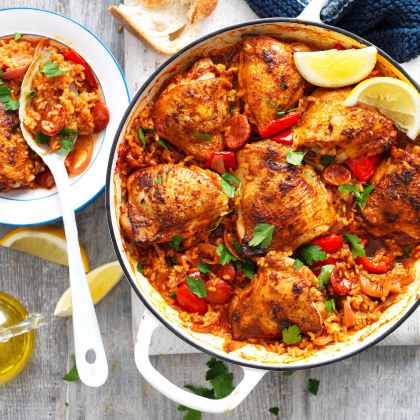How to fix a dish that is too salty
Oversalting is a cook's worst nightmare, but you can recover from this all too common kitchen mistake with any one of these easy fixes.
Dilute your dish
Adding a little bit of extra liquid can be a quick and simple way to correct oversalting a meal. Just be extra careful not to dilute the delicious flavours that have been cultivated. Here's how to do it:
- Remove about ½ cup of the sauce and discard. Then replace the same amount of removed sauce with either salt-reduced stock, wine or unsalted tomato passata.
- Adding a liquid high in fat is another great alternative. Try plain yoghurt, coconut cream, cream or milk.
- A good rule of thumb is to add something that will dilute the salt but not the flavour, so don't use plain water; get creative and add something with a little extra oomph but not extra salt.
Double up
Kill two birds with one stone by doubling up the recipe. Of course, you'll need some spare ingredients on hand but this approach will save your dish and put a few extra meals in the freezer ready for that time when you haven't done the shopping. Here's what to do:
- Make a second batch of the recipe BUT be sure to omit the salt completely.
- If you've used full-flavoured, ready-made stock, then ideally go for a salt-reduced version. If that's not possible, try replacing the stock with water.
- When the second batch is ready, simply mix it in with the original (now too salty) batch a little at a time until the saltiness has been balanced.
Bulk Up
Give your recipe an extra dose of fibre, and quickly reduce the saltiness of your dish by adding any extra vegetables you may have on hand in the fridge, freezer or pantry. Try foods such as zucchini, greens like spinach or even sweet potato chunks. This will not only bulk up the dish but will help to dilute the saltiness as the extra vegetables simmer and release their liquid.
Sugar hit
Depending on the type of recipe, adding a little sugar or alternatives such as maple syrup or honey can help to balance the saltiness of the dish. This works wonderfully in Asian cuisines or any tomato-based dish. Start by adding very small amounts, stir well and taste constantly before deciding to add more.
Tart it up
Adding a splash of something acidic such as vinegar, lemon juice or even wine to an over-salted dish can help to correct your meal and give it an extra tasty tang. Begin by adding a tablespoon at a time, stir well and taste.
HOT TIP: Add the acid at the end of the cooking time to avoid curdling any dairy that may be in the dish.
Add a starch
Adding a small amount of starchy food such as rice, barley, quinoa, pasta or couscous can help to absorb a salty sauce. Depending on the dish, simmer or bake it with a splash of extra liquid to allow the grains to absorb the excess salt.
Now that your scrumptious dinner has been saved, here are a few new family recipe ideas to try another day.
GET THE RECIPE: One Pan Spanish Chicken and Rice Bake by Rosella
GET THE RECIPE: Green Thai Curry Roast Chicken by Street Kitchen















